Ajit Pai's Broadband Legacy: Haste and Waste
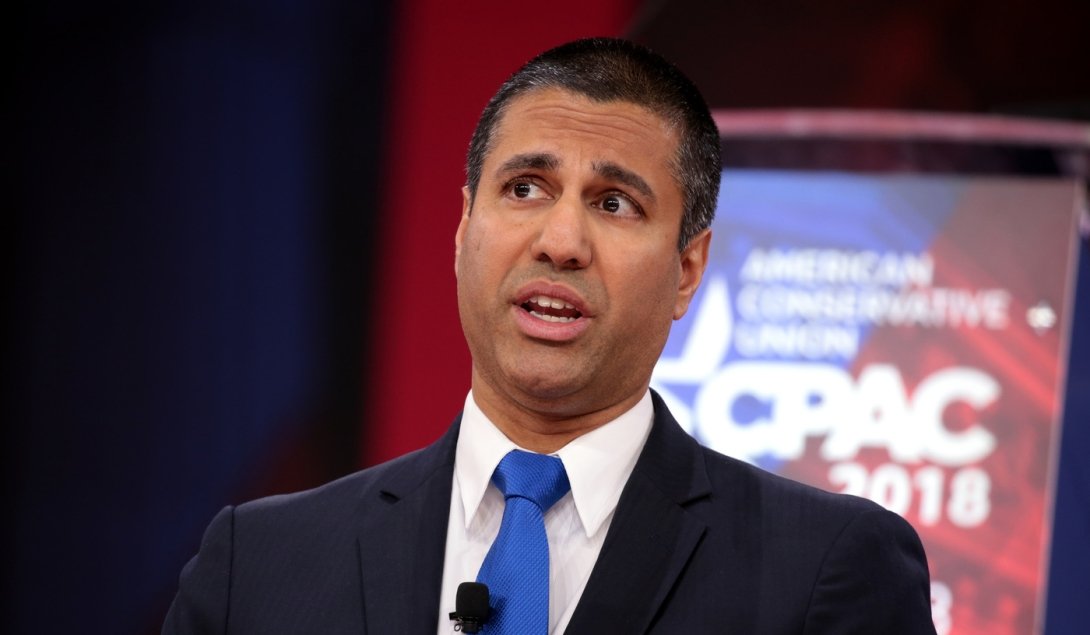
Original photo by Flickr user Gage Skidmore
Note: This is part four in an ongoing series. Be sure to check out the previous posts:
Part 1: Fiber to the Clubhouse: Pai Subsidizes Broadband for the Rich
Part 2: Broadband Boondoggle: Ajit Pai’s $886M Gift to Elon Musk
Part 3: Space-X Broadband: Coming to an Empty Traffic Island Near You
Part 5: Plan Fail: How Pai Imperiled a Rural Town’s Fiber Network
Part 6: Good News: Mass. Muni Fiber Spared from FCC RDOF Blunder
Part 7: Why Elon Musk Is No Longer Getting $886M from the FCC
As we documented in our previous three posts, the $9.2-billion Rural Digital Opportunity Fund (RDOF) — FCC Chairman Ajit Pai’s supposed crowning achievement toward closing the broadband digital divide — is looking more and more like one of the most wasteful projects in FCC history.
Our first post gave some examples of questionable funding in urban areas that we stumbled upon after spending just a few minutes with the map of winning bidders. This included ridiculous examples of “rural” subsidies awarded to major ISPs to offer broadband in gated urban communities where they already offer service, and awards to bring broadband to a posh resort that is already well-connected.
Our second and third posts focused on some eyebrow-raising subsidies granted to Starlink, Elon Musk’s soon-to-launch satellite-broadband company. The company received $886 million in subsidies, with $111 million of that for clearly urban areas — many of which are either already served, sparsely populated or completely devoid of people. Musk’s awards are the most egregious, as they include a seemingly endless number of subsidies to serve empty lots, road medians and well-connected industrial buildings in dense urban areas, even though Starlink is a satellite ISP intended to serve the most-rural areas of the country.
You might think that uncovering such embarrassing examples of waste would bring some sense of humility to the people responsible for it — but nope. When asked on C-SPAN’s The Communicators about money going to non-rural areas, Pai characterized our findings as a “nitpick” — claiming “those areas that some partisan activists have suggested are more urban in nature, those have been defined as unserved. So we were focusing on unserved areas wherever they happen to be.”
That’s a poor defense for the use of a supposedly rural fund in urban areas — and it’s especially inadequate given that Pai rushed this program despite concerns that the FCC’s maps were inaccurate. Now he’s essentially shrugging and saying “well, our maps said they’re unserved.” So, thanks for proving our point.
A few days later, Pai characterized the RDOF as an “overwhelming success,” even though the auction appears to be anything but, and the actual work of building broadband hasn’t begun. Pai also noted that — since some experts are critiquing the auction for giving the most money to unproven companies (LTD Broadband and Starlink), while others are raising concerns about incumbents with poor track records (e.g., Frontier) — this means the FCC “probably struck the right balance.”
Well, no, it doesn’t mean that. It just means Pai and his FCC messed up in multiple directions.
Critiquing the FCC for awarding more than $2 billion to unproven companies using questionable technologies to serve questionable areas is fully valid. So is raising concerns about awards to a bankrupt incumbent. These two critiques can coexist. Yet Pai views them as the bread of a “job well done” policy sandwich.
The Pai era is over. But he’s left behind many big messes that the new FCC and Congress must clean up, with the RDOF auction being just the latest.
The real cherry-pickers: ISPs like Charter and Starlink filling in holes on the map that they can’t or shouldn’t be subsidized to serve
Elon Musk has a devoted following. Earlier this month, a misunderstanding about his tweet plugging the secure messaging app Signal sent the stock of a totally different company with a similar name soaring more than 5,000 percent before people realized they were buying the wrong stock. So our work highlighting the questionable FCC awards to the side-company of one of the world’s wealthiest people was met with some fanboy backlash.
But while Pai himself, along with Musk’s fans and other random internet people, may have initially suggested that we’re engaged in “cherry-picking,” the reality is just the opposite.
Since the FCC’s RDOF awards cover nearly 60,000 census-block groups containing nearly 800,000 census blocks, uncovering these examples does not require cherry-picking. Just choose any urban or suburban area, and zoom in. What you’ll find is an abundance of ripe examples of waste, with ISPs like Musk’s Starlink that seemingly deployed a cherry-picking bidding strategy of their own.
Another critique of our analysis embodied in Pai’s own defense is that at least the bulk of the Rural Digital Opportunity Fund went to rural areas. Well, even if that seems true at first glance — because the overwhelming majority of awards were for blocks classified as rural — it does not mean that these rural awards were all legitimate.
Let’s venture outside the densely packed cities of Los Angeles, Philadelphia and New York, where we spent much of our previous three posts, and into rural communities. Let’s take a look at the area near Free Press’ historical home base in Western Massachusetts, far from the urban hub of Boston, and where some people still struggle to get adequate internet service.
All RDOF awards in Massachusetts went to Charter and Starlink (summarized here, with Charter listed as “CCO Holdings,” and Starlink as “Space Exploration Technologies Corp.”). Running counter to expectations, the majority of rural-focused Starlink’s winning areas are in the better-served eastern part of the state. Meanwhile, Charter’s are all in the central and west-central areas — regions that the company and other incumbents have ignored in the absence of subsidies.
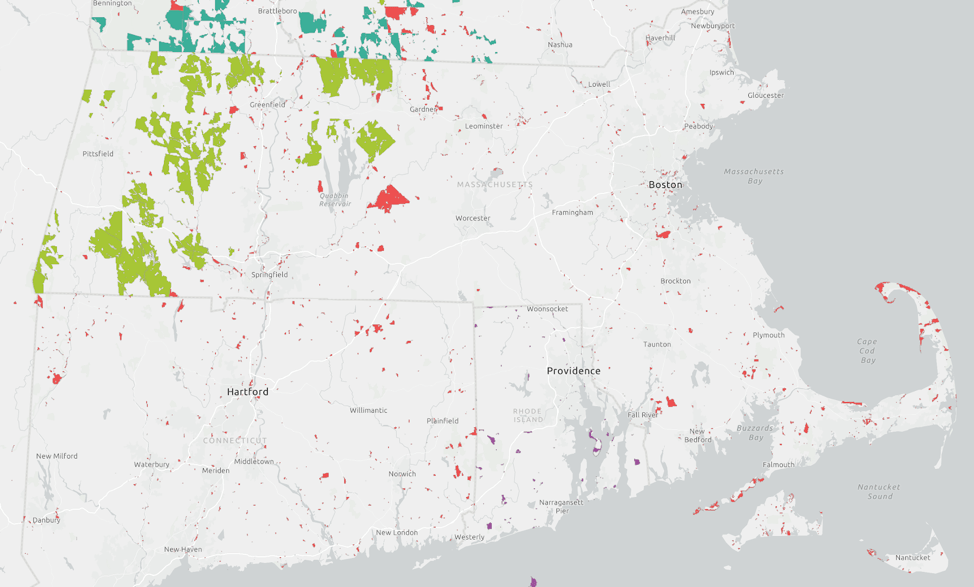
Massachusetts RDOF winning areas. Starlink-winning areas appear in red and Charter-winning areas are in green.
Cooperative Network Services, LLC
Charter won $21.6 million of the state’s $32.6-million total RDOF support, awarded to bring gigabit service to 42 census-block groups containing 1,264 individual census blocks. Why bother noting the different number of block groups and blocks?
Well, the FCC determines whether an area is served at the most-granular level, which is the census block — but the RDOF rules award subsidies to the ISPs at the larger-block group level. As we show below, this discrepancy led to situations where the FCC is paying companies to serve census blocks that are “holes” in geographically larger block groups in which those same winning bidders or other ISPs already serve without subsidies. This is happening even if these served and unserved areas are separated by mere feet and even if the entire block group is not designated as “rural.”
And it seems in a number of instances that these holes in the broadband-deployment Swiss cheese are there for an understandable reason: They don’t contain any homes or buildings.
In Westfield, Massachusetts, Charter committed to deploying gigabit in tiny areas that are completely surrounded by Comcast and utility-company gigabit broadband
Our tour of Western Massachusetts begins in Westfield, a Pioneer Valley town that’s home to the historic Whip Company Complex, which is a tourist destination of very specific appeal. Right away we see a Charter RDOF block group that is adjacent to a rural airport (a topic covered in our second post).
Charter will receive $61,364 over 10 years to bring service to a reported 75 customer locations in this area (which, according to other FCC estimates, coincidentally contains 75 people living in an estimated 42 housing units). This census-block group consists of both rural and urban blocks, with more than half classified as rural. That’s because the Census Bureau classifies a block as urban or rural based on the individual block’s population density, not its surroundings.
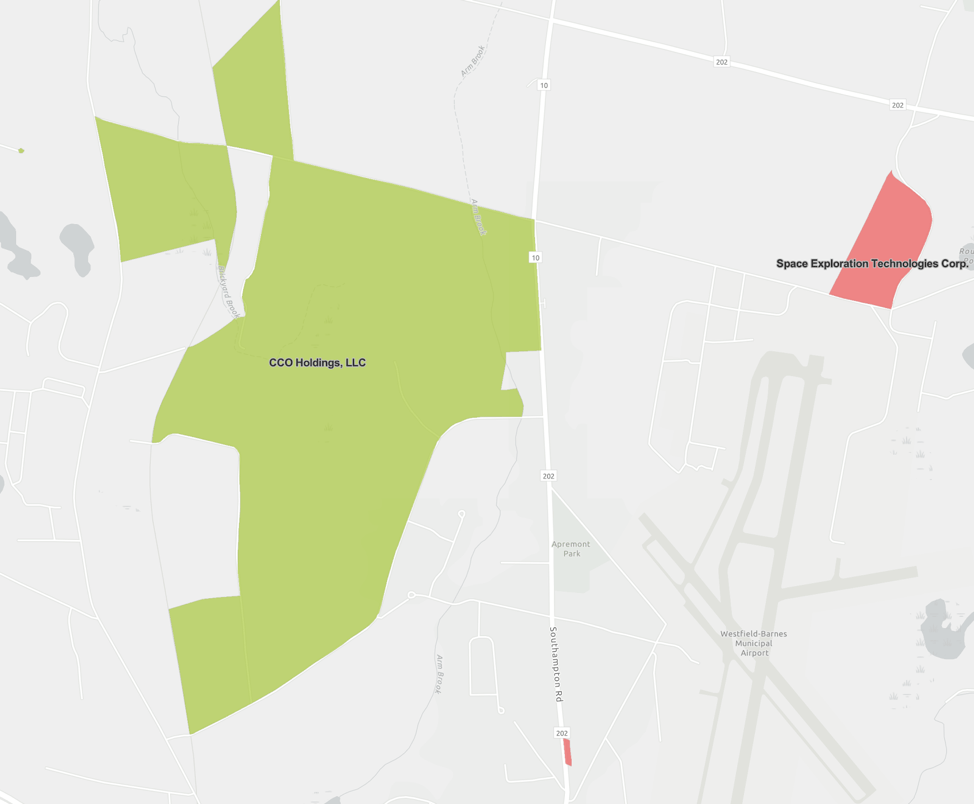
Cooperative Network Services, LLC
This Charter award area contains just eight subsidy-eligible blocks, but they’re part of a larger census-block group containing 79 blocks, most of which are either already served or unpopulated.
The most recent public FCC deployment data for this area indicated there were 35 “unserved” blocks in this group. It appears that the FCC deemed only eight of these blocks RDOF-eligible because the agency’s modeling data indicated there were serviceable locations there, while in the other 27 blocks there were not.
This is likely because the FCC believed these blocks were unpopulated or that its population estimates of one person were false positives. Even if the agency did knock out some blocks in this manner, on the basis that they were unpopulated, the FCC still funded Charter to build to areas in this very same census-block group that are also obviously unpopulated and also have no serviceable business locations.
This is a frustratingly common feature of the RDOF: It’s funding companies to “fill” questionable Swiss-cheese holes — supposedly unserved blocks within a partially served block group. The FCC’s RDOF rules permitted ISPs to bid for subsidies in these types of areas even though the block group is partially covered, and even though the supposedly uncovered blocks may not be truly “high cost” areas where it would be prohibitively expensive for the existing ISP to expand its coverage even without a subsidy.
As we discuss below, this particular winning RDOF area for Charter is located inside of the service footprints of Comcast (which already offers gigabit service there), Verizon (which offers only DSL), and Westfield Gas & Electric (“G&E”) — the rare power company that built its own fiber-broadband service.
We have no way of knowing if any of the potential customers in these eight blocks were denied faster service by Comcast and Westfield G&E. But a little common sense and a look at what’s actually located in these blocks lead us to suspect that these areas never saw advanced deployment because of a lack of demand — either because no one lives or even works there, or because for the most part they have no residential properties and the few businesses there may not need advanced services.
Is Charter filling real holes in a deployment “Swiss cheese,” or just filling its pockets?
Digging into this area illustrates the problems in Pai’s RDOF design. Charter was able to bid on this block group because some of the blocks within it show up in the FCC’s Form 477 deployment data as lacking an ISP offering fixed service at a 25/3 Mbps level. But that doesn’t mean this is a true high-cost area that needs rural-deployment subsidies. Nor does it mean there are people living in most of these newly subsidized areas.
Only six of the eight subsidy-eligible blocks that make up this particular Charter RDOF award area are classified as rural, because the population density in the other two is too high. According to the FCC’s population estimates, these eight blocks are home to 75 people. But because of the FCC’s broken system for determining eligible areas, we see that 50 of these 75 people live in just one single, rural-classified block, where according to the FCC’s own data, Westfield G&E already offers gigabit-fiber service.
How did that happen? This block wasn’t claimed by Westfield G&E in the June 2019 deployment data (the last round of data submitted ahead of the FCC determining eligible blocks), but was claimed in data filed six months later.
Of the supposed remaining 25 people, 21 live in a portion of a mobile home park that is surrounded by Comcast and Westfield G&E gigabit deployments. This particular supposedly unserved area that Charter won subsidies for is the highlighted oval in the screenshot below.
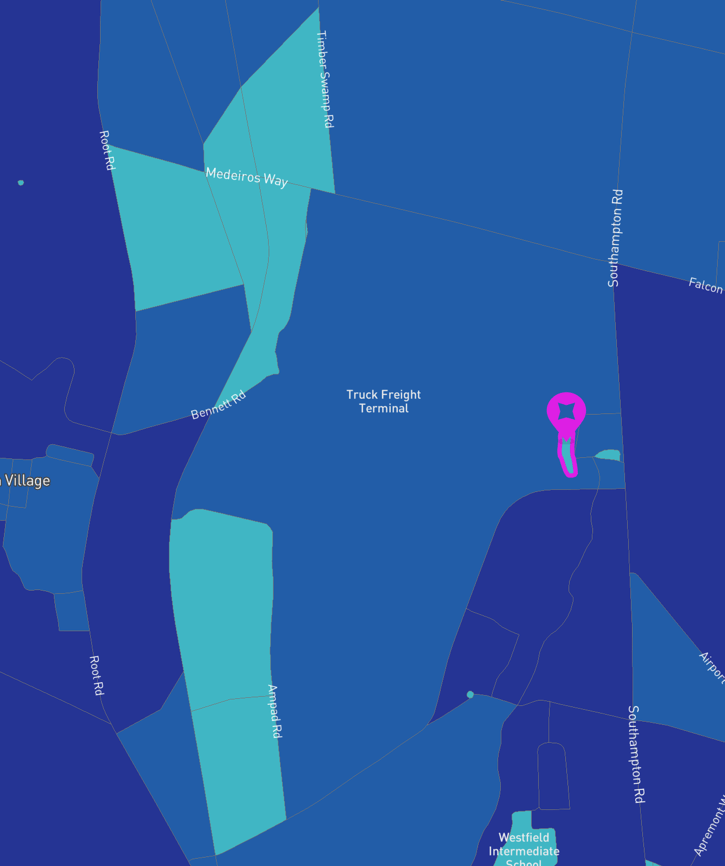
The people living in this little island without deployment absolutely deserve to be served. But it’s ridiculous to think that subsidizing Charter — a cable company that doesn’t serve this area at all — is the best way to do it, especially since Comcast and Westfield G&E already offer service everywhere surrounding these mobile homes.
Indeed, if Ajit Pai hadn’t given away Title II authority, the FCC (or the state utility commission) could have determined that Comcast was the “carrier of last resort” in this corner of the mobile home park, and told Comcast it was obligated to extend its lines a few feet if the people living there requested service.
Charter’s bold plan to bring broadband to the birds
But this little corner of Western Massachusetts also contains one of the more visually stunning examples of RDOF waste, similar to one we highlighted in our third post.
As we noted above, 21 of the 25 supposedly unserved people residing in these Charter RDOF-winning blocks are in the Swiss-cheese “hole” of an already well-served mobile home park. So where are the remaining four people? Well, according to the FCC, they live in a tiny census block that’s surrounded on all sides by Comcast and Westfield G&E gigabit service (shown below).
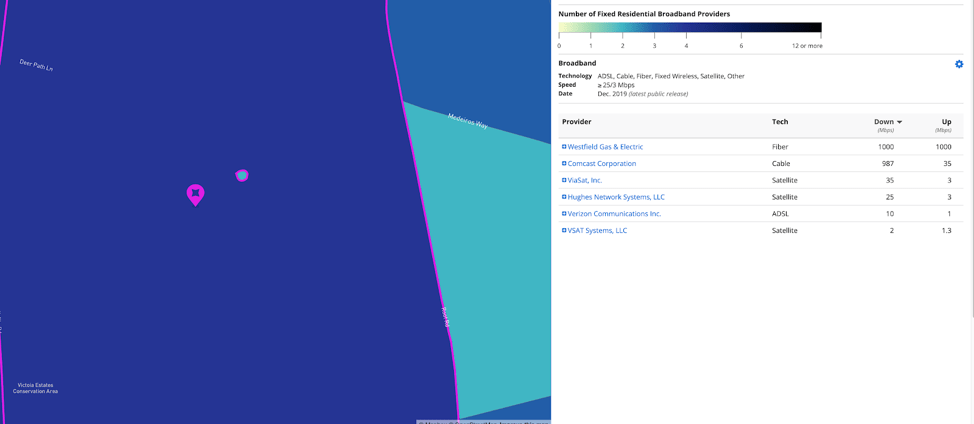
This Charter award area — where the company is now legally obliged to deploy gigabit service — is that tiny light-blue dot in the picture above. As they say on TV crime dramas, “enhance the image!”
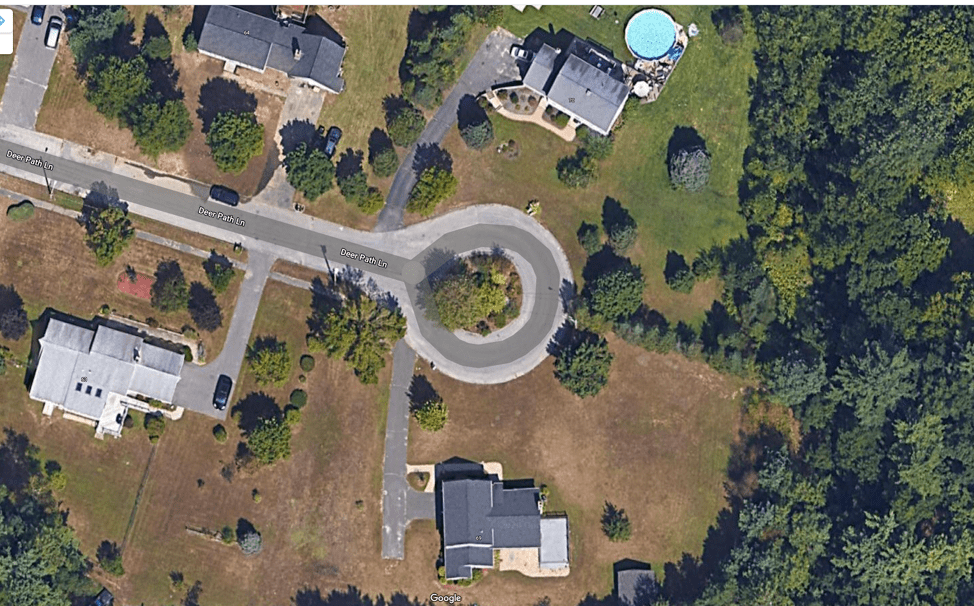
According to the FCC’s housing and population estimates, this tiny circle supposedly contains four people residing in one housing unit. But it isn’t one of the four homes you see pictured above — those are all located in a different census block, which is already well-served by Comcast and Westfield G&E and was not RDOF-eligible. The Charter RDOF-winning “block” consists solely of the miniscule plot of trees at the center of this turnabout; all the land on the other side of the street is in the adjacent, already served block.
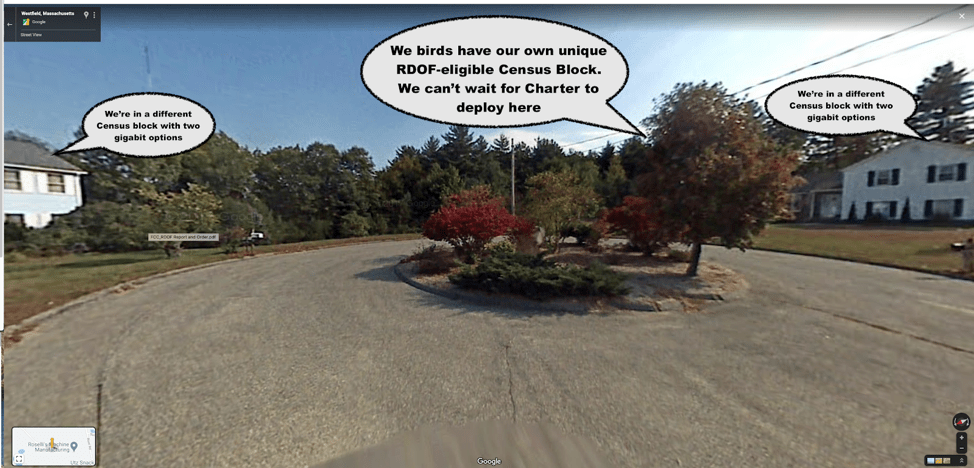
So we see that the FCC’s population and housing estimates aren’t always accurate. We also see the likely result of an RDOF design flaw: Charter will be paid to serve this block, but unless birds start tweeting online and request a fiber-to-the-nest line, Charter will never have to worry about actually deploying anything in this area.
This is not, as Chairman Pai said, what an “overwhelming success” looks like. This is but one of many embarrassing failures that did not have to happen.
Indeed, last summer when FCC Commissioner Jessica Rosenworcel objected to Pai’s RDOF plan, it was in part because she knew that the FCC’s maps and data were not accurate. She also recognized that the forthcoming changes required by the Broadband DATA Act would help spot areas that don’t actually contain serviceable locations — and catch the serviceable locations in truly rural areas the FCC’s data missed.
The agency’s subpar maps sometimes overstate coverage, but as we can see in this post and our previous three as well, those maps can sometimes understate coverage too, making it look like an area is not served when it actually is or easily could be served without any subsidy. But Pai and his fellow Republican commissioners ignored the objections from Rosenworcel and Commissioner Starks, and rushed $9.2 billion out the door.
Now Rosenworcel and Starks will have to clean up Pai’s mess once he’s finished his self-congratulatory victory lap and moves on to whatever cushy industry job awaits.
Money for no one and oversight-free
To recap, Charter won RDOF funds to serve this partially rural census-block group, with the FCC’s award summary listing eight blocks.
Of these eight blocks, the agency’s data indicates that people reside in only three of them. And as we showed above, of these three supposedly populated blocks, one contains nothing but a couple of bushes, one contains most of this area’s population and is already served by gigabit fiber, and the final block is surrounded on all sides by Comcast and Westfield G&E gigabit deployments. So doing the math, there are five other Charter RDOF blocks here that are unpopulated.
What’s there? Let’s find out.
We’ll start with the block at the very tip top of this Charter award-block group. This is a single block of roughly one square mile where the only fixed provider is Verizon, offering 5 Mbps DSL. But the block is bordered to the north, east and west by other blocks with gigabit deployment. What’s in this block? A propane-supply-company storage building. The block directly to the north of the red line in the picture below was not eligible for RDOF. That’s because Comcast already offers gigabit service to the flower shop, machine shop and garbage-collection service located there.
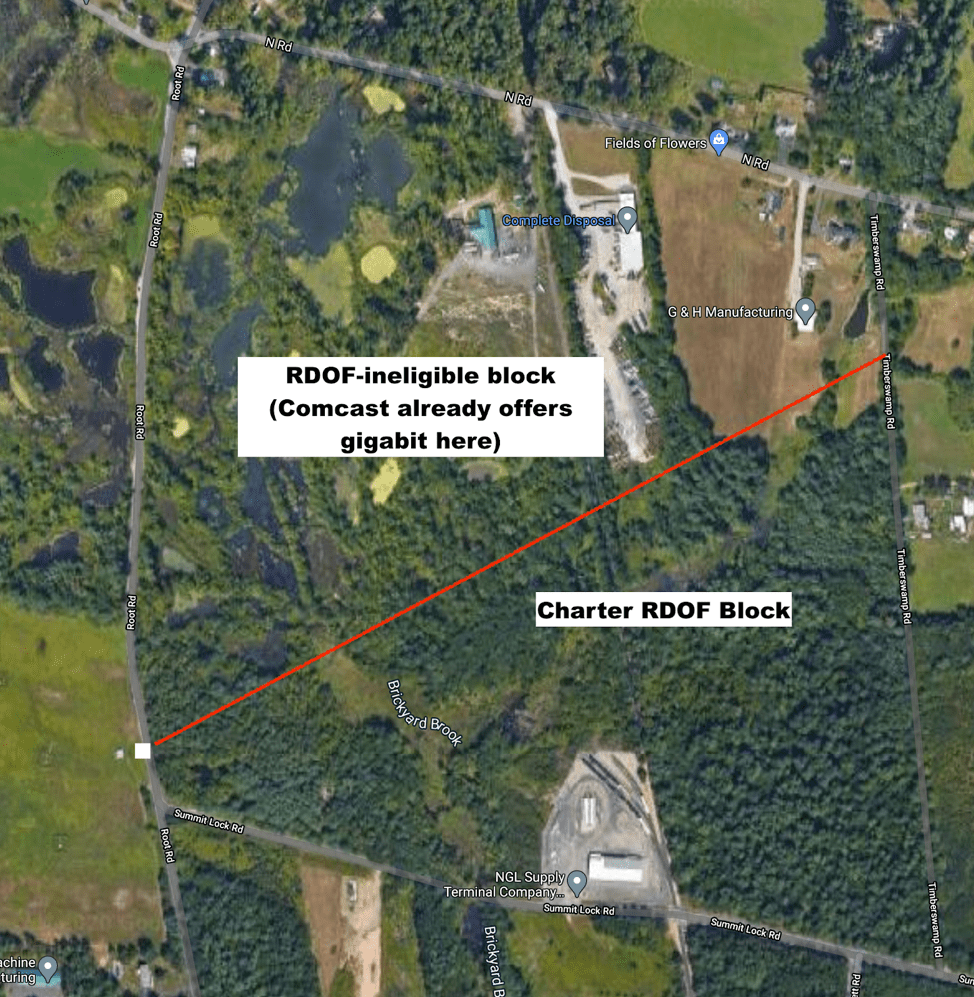
We see a similar story if we move west from this block to the oddly shaped one seen above in this post’s second picture. This square mile of land shows up as unserved in Form 477, even though the blocks directly across the street (which contain actual homes people live in) have gigabit-level service available from Comcast and Westfield G&E. The business park in this now-funded Charter RDOF block includes an aquatics center and dance studio.
We can’t say whether the Verizon DSL offered to these businesses is inadequate for their needs, or if they ever requested service from Comcast or Westfield G&E and were denied. What we can say is that pictures of this area show those two ISPs’ fiber and coaxial cable lines — which feed the homes on the west side of the street — on the utility poles just a few feet away from these businesses.
There’s no need to subsidize an ISP to serve these commercial locations, since there’s nothing unique about these final “line drops” needed to get the wires across the street that makes them “high cost.” Yet this is an RDOF area, and an especially perplexing one given that the subsidy went to Charter — a company that doesn’t have existing infrastructure here, while Comcast and Westfield G&E do.
The rest of this Charter RDOF census-block group is similar.
The southern tip contains a small block that is bordered on all sides by gigabit-deployment blocks. But because this Swiss-cheese-hole block is home to a few industrial storage buildings, and it shows up in Form 477 as having only Verizon DSL service, Charter was able to bid and win subsidies to serve there. That’s wasteful, like everything else we’ve documented here. Nothing suggests the need for deployment subsidies there, as there are three wired ISPs operating in this relatively typical exurban area, with two of them offering gigabit broadband.
Charter played by the FCC’s broken rules
To be clear, it looks like Charter played by the FCC’s rules. But those rules are broken.
Charter was able to bid for subsidies here because even though it’s obvious that Comcast and Westfield G&E could extend their gigabit services a few more feet without extraordinary resources — the FCC’s standard for marking an area as served on Form 477 — those other two ISPs did not claim these areas. Why didn’t Comcast or Westfield G&E claim the blocks with the propane company, dance studio and industrial storage buildings as ones they could potentially serve without extraordinary resources?
We don’t know! Perhaps it’s because they followed the letter of the FCC’s requirements, which don’t make it clear that ISPs should claim all blocks in their serviceable areas even if there’s never going to be demand in some of them. But it’s not because the propane company is hard to reach — it’s just a single large shed located right off the street, mere feet away from the utility poles where you can see the fiber and coax lines running. The same is true for all of the other properties discussed above.
For whatever reason, the nearby incumbents didn’t claim these blocks as served, and they don’t appear to have challenged the eligibility of these blocks for RDOF. It’s highly likely that this sort of non-claimed/non-challenged Swiss cheese led to a substantial amount of indefensible RDOF waste.
What’s more, anyone — and that includes the staff at the FCC and Charter — who has spent any amount of time studying telecom markets understands that cable companies do not dare deploy in each other’s “franchise” areas. That makes the Westfield-area RDOF results all the more perplexing. There’s just no way Charter is planning to build gigabit-level services in Comcast’s territory.
But wait, it gets worse! In our next post we will continue to explore areas of the Pioneer Valley where Charter won RDOF awards, including subsidies to overbuild in rural areas where there is not only already gigabit service, but gigabit service that the FCC actually subsidized in its last auction just before RDOF.